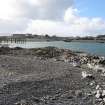Notice
Following a review of the Buildings at Risk Register we have paused the Register while we consider options for its future.
The website will remain accessible and searchable during this time, but it will not be updated and we’re not accepting nominations for additions to the Register. If you need to contact us about the BARR please email hmenquiries@hes.scot
Read the review report here and you can find out more about why we have paused the BARR on our news centre.
Wooden pier extension, Ellenabeich
Ordnance Survey licence number AC0000807262. All rights reserved. © Copyright and database right 2025. Public Sector Viewing Terms
Useful Links
- Canmore:
- SEIL, ELLENABEICH, WOODEN PIER
General Details and Location
Category
AT RISK
Name of Building
Wooden pier extension
Other Name(s)
Address
Ellenabeich
Locality
Postcode
Planning Authority
Divisional Area
Reference No
4622
Listing Category
Unlisted
OS Grid Ref
NM 74120 17178
Location Type
Rural Settlement
HS Reference No
Description
Wood piled pier on a T-plan extending from a slate rubble earlier pier constructed for the slate idustry. Wood and iron post crane was sited on the pier head. (J.Hume)
Built to service the the large quarry village of Ellenabeich and by small-boat ferry, the smaller village on Easdale Island. It dates from the period when most places in the west highlands depended on steamers for their trade. (RCAHMS)
Seil forms part of "the Slate Islands" along with Luing, Easdale and Belnahua, noted from 1631 as suppliers of the finest slates. Urban growth ensured prosperity for Scottish slate's industry for much of the 19th century, although latterly suffering from competition from Welsh slate. (J Butt)
So immense was the output that Ellenabeich, hitherto an island like Easdale, became linked to Seil by a causeway of quarry waste. (FA Walker)
Built to service the the large quarry village of Ellenabeich and by small-boat ferry, the smaller village on Easdale Island. It dates from the period when most places in the west highlands depended on steamers for their trade. (RCAHMS)
Seil forms part of "the Slate Islands" along with Luing, Easdale and Belnahua, noted from 1631 as suppliers of the finest slates. Urban growth ensured prosperity for Scottish slate's industry for much of the 19th century, although latterly suffering from competition from Welsh slate. (J Butt)
So immense was the output that Ellenabeich, hitherto an island like Easdale, became linked to Seil by a causeway of quarry waste. (FA Walker)
Building Dates
Circa 1870
Architects
Unknown
Category of Risk and Development History
Condition
Poor
Category of Risk
Moderate
Exemptions to State of Risk
Not to be confused with the rubble built slate pier.
Field Visits
17/09/2009, 28/9/2012
Development History
September 2009: Inspection finds the wooden pier extension ruinous and deteriorating.
28 September 2012: Inspection finds the pier extension continues to decay slowly. Previously in good condition and not considered at risk, the slate pier section has suffered storm damage and is breached in two places.
Availability
Current Availability
Unknown
Appointed Agents
Price
Occupancy
Vacant
Occupancy Type
N/A
Present/Former Uses
Name of Owners
Type of Ownership
Unknown
Information Services
Additional Contacts/Information Source
Bibliography
The Industrial Archaeology of Scotland Highlands & Islands (1977) John Hume p 167 The Industrial Archaeology of Scotland John Butt p 95-98 Buildings of Scotland Argyll and Bute (2005) Frank Arneil Walker p 245
Online Resources
Classification
Shipping
Original Entry Date
11-MAY-10
Date of Last Edit
22/02/2018






